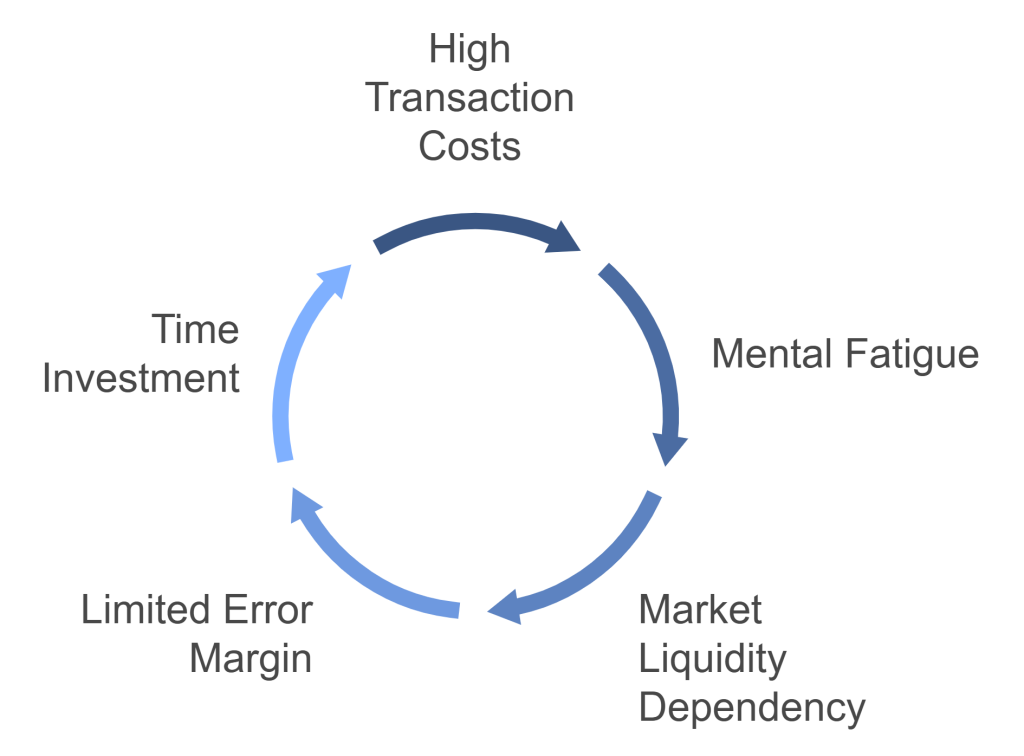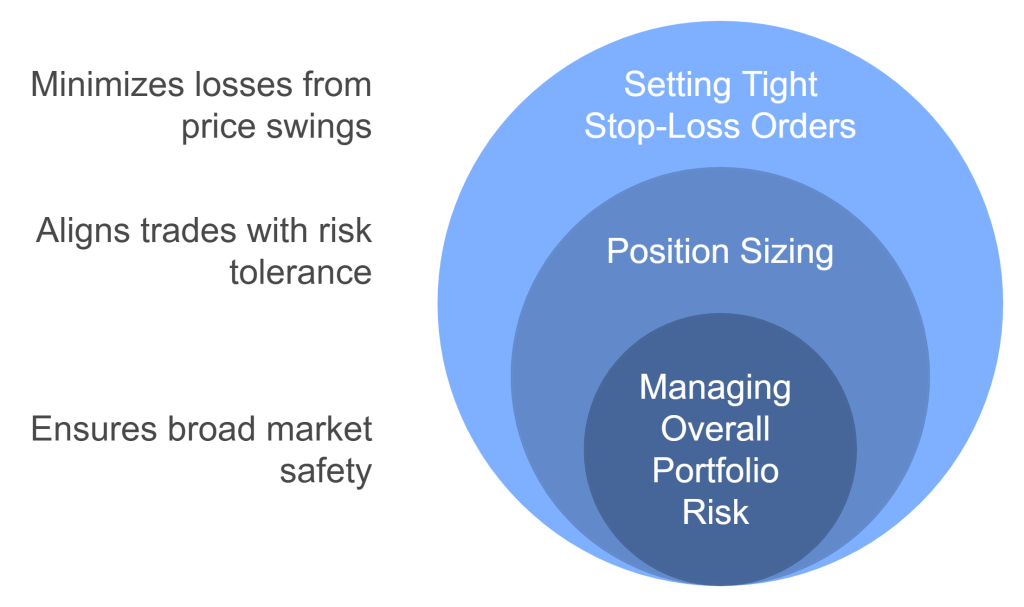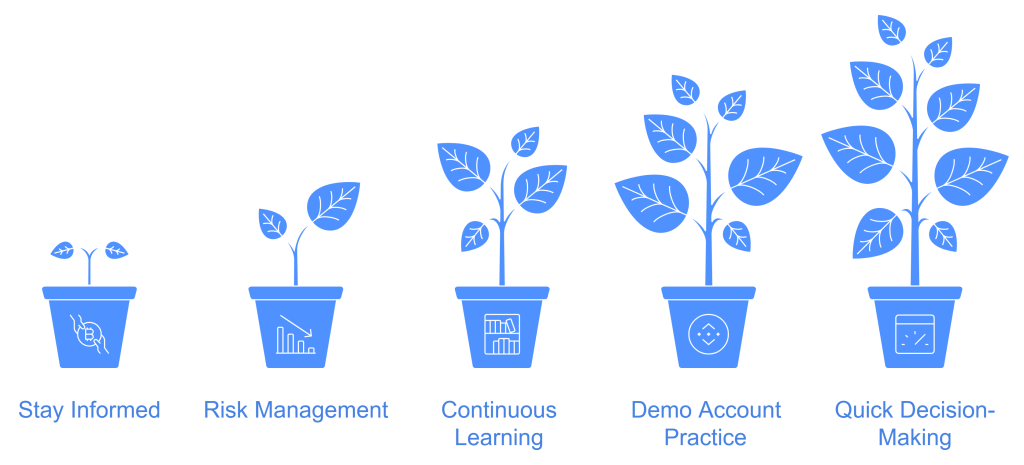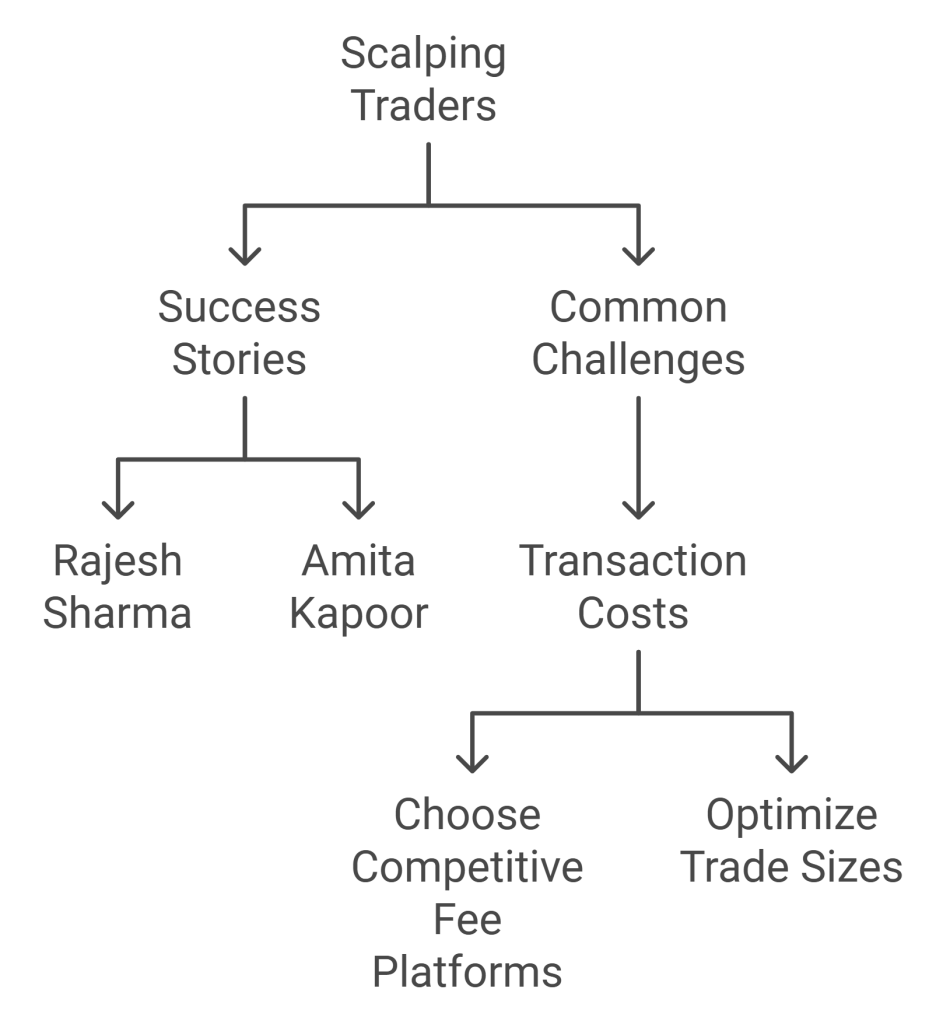Introduction
A. Captivating Introduction:
In the ever-evolving tapestry of India’s stock market, Scalping Trading emerges as a captivating strategy, promising swift gains from minor price fluctuations.
Imagine the thrill of making significant profits in a matter of minutes.
B. Definition of Scalping Trading:
In the vast Indian market, this technique requires finesse and precision.
C. History and Evolution:
Scalping’s roots trace back through the evolution of trading practices.
From its humble beginnings to its current prominence, understanding its journey provides insights into its effectiveness in contemporary markets.
D. Significance and Popularity:
In a market with a staggering ₹280 lakh crore capitalization, scalping stands out, especially among the 80 million active demat account holders.
Its popularity is a testament to its potential for quick and frequent profits.
E. Benefits and Drawbacks:
In the intricate realm of Scalping Trading within the Indian stock market, understanding the benefits and drawbacks is crucial for aspiring traders.
Let’s dissect this strategy to unveil the potential rewards and challenges it presents.

Benefits of Scalping Trading:
a. Quick Profit Accumulation:
Scalping is synonymous with speed. By capitalizing on small price movements, traders can accumulate profits rapidly, making it an attractive strategy for those seeking immediate returns.
b. Adaptability to Market Conditions:
Scalping is agile and adapts well to different market conditions.
Whether in a trending or ranging market, the strategy’s flexibility allows traders to find opportunities across various scenarios.
c. Reduced Exposure to Market Risks:
Given the short holding periods, scalp traders are exposed to the market for minimal durations.
This reduced exposure minimizes the impact of overnight risks and unexpected market developments.
d. Enhanced Discipline and Focus:
Scalping demands a high level of discipline and focus due to its rapid pace. Traders must stay vigilant and make swift decisions, cultivating a disciplined mindset beneficial for overall trading.
e. Leverage on Volatility:
In a market as dynamic as India’s, scalp trading leverages volatility as an asset. The strategy thrives on the frequent price fluctuations that occur throughout a trading day.

2. Drawbacks of Scalping Trading:
a. Transaction Costs Impact:
Despite aiming for small price movements, the cumulative impact of transaction costs can erode profits. Traders need to carefully manage costs to ensure that the benefits outweigh the expenses.
b. Stress and Mental Fatigue:
The rapid decision-making and constant monitoring inherent in scalp trading can lead to heightened stress levels and mental fatigue.
Traders need robust mental resilience to navigate these challenges successfully.
c. Dependency on Market Liquidity:
Scalping is most effective in liquid markets with ample trading activity. In less liquid markets, executing rapid trades becomes challenging, potentially limiting the strategy’s effectiveness.
d. Limited Room for Error:
With small price movements being the focus, there is limited room for error in scalp trading. One miscalculated move can result in losses, underscoring the importance of precision in execution.
e. Requires Significant Time Investment:
Scalp trading demands constant attention and quick decision-making. Traders must commit significant time to monitor markets and execute trades, making it less suitable for those with time constraints.

Basics of Scalping
In the heart of the bustling Indian stock market, understanding the fundamental aspects of Scalping Trading is akin to mastering the rhythm of a fast-paced dance.
This section delves into the essential basics, shedding light on the time frame, execution speed, and the meticulous focus on small price movements that define this exhilarating trading strategy.
A. Overview of the Scalp Trading Time Frame (Intraday):
Scalping operates within the confines of the intraday time frame, capturing the essence of swift market movements occurring within a single trading day. This temporal limitation sets scalp trading apart from other strategies, requiring traders to open and close positions promptly.
B. Rapid Trade Execution and Short Holding Periods:
The crux of scalp trading lies in its ability to execute trades with lightning speed. Traders must possess the agility to enter and exit positions swiftly, leveraging the ebb and flow of the market. Short holding periods distinguish scalp trading, as positions are typically held for minutes rather than days or weeks.
C. Focus on Small Price Movements for Profit:
Unlike traditional trading strategies that seek substantial price movements, scalp trading thrives on the meticulous observation of small price fluctuations.
Traders aim to capture minimal shifts in the market, accumulating profits through the sheer frequency of trades.

How Scalping Works
In the intricate dance of the Indian stock market, the mechanics of Scalping Trading unfold as a strategic art form.
This section unravels the inner workings of scalp trading, shedding light on the careful selection of markets, the critical importance of low transaction costs, and the leverage of technical analysis for precision in entry and exit points.
A. Selection of Liquid and Volatile Markets:
At the core of successful scalp trading lies the astute selection of markets characterized by high liquidity and volatility.
Liquidity ensures the smooth execution of rapid trades, while volatility provides the price movements necessary for scalp traders to capitalize on.
In India’s dynamic stock market, identifying and navigating these opportune markets becomes a key determinant of success.
B. Importance of Low Transaction Costs:
Scalp traders operate on the premise that small price movements can translate into profits. However, the cumulative impact of transaction costs can significantly affect overall profitability.
Hence, managing and minimizing transaction costs is paramount for scalp traders, requiring a meticulous approach to trade execution.
The focus on low transaction costs underscores the need for traders to choose platforms and brokers judiciously. Opting for institutions that offer competitive fees and efficient order execution becomes a strategic decision in the realm of scalp trading.
C. Leveraging Technical Analysis for Entry and Exit Points:
In the fast-paced world of scalp trading, decisions are not left to chance. Technical analysis becomes the compass guiding traders through the labyrinth of market movements.
By utilizing charts, patterns, and indicators, scalp traders identify precise entry and exit points, enhancing the probability of successful trades.

Scalping Strategies
As we delve into the captivating world of Scalping Trading within the dynamic realms of the Indian stock market, the spotlight shifts to the intricacies of scalp trading strategies.
This section unwraps the artistry involved in reading price action, identifying support and resistance, and leveraging technical indicators—key components that distinguish successful scalp traders.
A. Reading Price Action and Charts:
Scalp traders are akin to market interpreters, reading the subtle nuances of price action and charts to anticipate market movements.
The ability to discern patterns, trends, and potential reversals in real-time becomes an art form. By scrutinizing minute fluctuations, scalp traders gain insights into the market’s immediate future.
Mastery in reading price action involves understanding candlestick patterns, recognizing trends, and interpreting chart formations.
Successful scalp traders develop a visual acuity that allows them to navigate the complexities of the market with precision.
B. Identifying Support and Resistance Levels:
Support and resistance levels act as the cornerstone of scalp trading strategies. Traders keenly identify these pivotal points where the market historically experiences shifts.
Recognizing and interpreting these levels empower scalp traders to make informed decisions regarding entry, exit, and risk management.
The art of identifying support and resistance is not merely about recognizing lines on a chart. It involves understanding the psychological aspects of market participants and the potential impact of these levels on future price movements.
C. Utilizing Technical Indicators (e.g., Moving Averages, RSI):
Technical indicators serve as the compass guiding scalp traders through the market’s ebbs and flows. Moving averages, the Relative Strength Index (RSI), and other tools become invaluable in confirming trends and identifying potential entry and exit points.
In India’s vibrant market, where data is a currency of its own, leveraging these indicators adds a layer of sophistication to scalp trading.

Risk Management in Scalping
A. Setting Tight Stop-Loss Orders:
Scalp traders rely on tight stop-loss orders to minimize losses. The precision of these orders is crucial in a strategy where small price movements can make a significant impact.
B. Position Sizing:
Effective position sizing ensures that each trade aligns with the trader’s risk tolerance. Balancing position sizes relative to the expected price fluctuations is a key element in risk management.
C. Managing Overall Portfolio Risk:
Beyond individual trades, successful scalp traders consider the broader portfolio. Diversification and risk mitigation strategies are employed to manage overall portfolio risk effectively.

Scalping vs. Other Trading Styles
A. Contrasting with Day Trading and Swing Trading:
Day trading and swing trading serve as alternatives to scalp trading. Contrasting their characteristics provides insights into the varied approaches traders can adopt based on their preferences and risk tolerance.
B. Advantages and Disadvantages:
Understand the advantages and disadvantages of scalp trading in comparison to other styles. The benefits of quick profits must be weighed against the challenges of constant vigilance and rapid decision-making.
C. Suitability for Different Market Conditions:
Scalp trading’s adaptability is showcased in its suitability for various market conditions. Whether in bullish or bearish markets, understanding how scalp trading aligns with different conditions is essential.

Technology and Scalping
A. Advanced Trading Platforms:
Cutting-edge trading platforms empower scalp traders with real-time data and rapid execution capabilities. The evolution of technology has transformed scalp trading into a sophisticated endeavor.
B. Automation in Scalp Trading:
Automation plays a pivotal role in scalp trading, especially with the rise of algorithmic trading. Traders leverage automated systems to execute trades swiftly and efficiently.
C. Algorithmic Trading Impact:
The influence of algorithmic trading on scalp strategies is profound. Understanding this impact sheds light on how technology shapes the landscape of scalp trading.
Psychological Aspects of Scalping
As we immerse ourselves in the intricate world of Scalping Trading within the expansive landscape of the Indian stock market, understanding the psychological underpinnings becomes paramount.
This section delves into the mental fortitude required for scalp trading, exploring how successful traders navigate stress, uphold discipline, and manage emotions in the face of rapid decision-making.
A. Dealing with Stress and Pressure:
The world of scalp trading operates at a rapid pace, where split-second decisions can make the difference between profit and loss. Successful scalp traders have honed the ability to deal with stress and pressure effectively.
The volatility of the Indian market, coupled with the immediacy of scalp trading, demands a resilient mindset.
Strategies for managing stress involve maintaining a calm demeanor amidst market fluctuations. Techniques such as mindfulness, deep breathing, and mental exercises become tools in the arsenal of scalp traders aiming to navigate the intense environment.
B. Importance of Discipline and Focus:
Discipline is the bedrock upon which successful scalp trading is built. The need for a structured and systematic approach underscores every trade.
Scalp traders adhere to pre-defined strategies and rules, ensuring consistency in decision-making.
In the fast-paced world of scalp trading, distractions can be detrimental. Successful traders maintain an unwavering focus, shutting out noise and staying attuned to their strategies.
Discipline extends beyond the trading desk, encompassing risk management and adherence to a meticulously crafted plan.
C. Managing Emotions During Rapid Trading Decisions:
Emotions run high in the rapid-fire environment of scalp trading. Successful traders are adept at managing these emotions, preventing them from clouding judgment.
From excitement during profitable trades to frustration in the face of losses, understanding and channeling emotions is a key skill.

Scalping in Different Markets
A. Scalping in Equities:
Explore how scalp trading manifests in the equity market. The nuances of trading stocks and the unique opportunities it presents for scalp traders.
B. Scalping in Forex Markets:
Unpack the complexities of forex scalp trading. Understand how currency markets provide a fertile ground for scalpers seeking diverse opportunities.
C. Scalping in Cryptocurrency Markets:
Cryptocurrency markets, known for their volatility, offer a unique landscape for scalp trading. Discover the challenges and rewards in navigating this dynamic arena.

Putting Scalping Trading into Practice
As we transition from theory to application in the realm of Scalping Trading within the vibrant tapestry of the Indian stock market, this section serves as a guide for aspiring traders.
From selecting the right market to executing orders, the step-by-step process outlined here emphasizes the importance of a comprehensive trading plan, risk management, and the need for meticulous preparation.
A. Selecting the Right Market:
The journey into scalp trading begins with the selection of the right market. In India’s diverse financial landscape, traders have an array of options, from equities to forex and cryptocurrencies.
Each market presents unique challenges and opportunities, and the choice depends on the trader’s expertise and preferences.
Successful scalp traders understand the nuances of their chosen market, recognizing patterns and behaviors that may influence short-term price movements.
In a market as dynamic as India’s, staying abreast of sector-specific news and global economic trends is paramount.
B. Developing a Comprehensive Trading Plan:
A solid trading plan is the compass that guides scalp traders through the labyrinth of market fluctuations.
This plan should outline entry and exit rules, risk management parameters, and the overarching strategy. Traders should define their risk tolerance, set profit targets, and establish criteria for trade selection.
The comprehensive trading plan serves as a roadmap, providing clarity and structure amidst the chaos of rapid decision-making.
It becomes a reference point, helping traders stay disciplined and focused during the intensity of scalp trading.
C. Backtesting Scalping Strategies:
Before venturing into live markets, successful scalp traders invest time in backtesting their strategies.
This involves analyzing historical data to assess the effectiveness of their approach. By simulating trades in a risk-free environment, traders gain insights into how their strategies would have performed in different market conditions.
Backtesting allows traders to refine their strategies, tweak parameters, and identify potential pitfalls. It’s a crucial step in the preparation phase, enabling traders to approach live markets with a tested and optimized plan.
D. Order Execution and Monitoring:
With the plan in place and strategies refined, execution becomes the focal point. Traders need to choose a reliable platform that offers quick and efficient order execution.
In India’s landscape, where online trading dominates, selecting a platform with real-time data, low latency, and user-friendly interfaces is key.
Reference: Zerodha Online Trading

Tips for Successful Scalp Trading
Embarking on the journey of Scalping Trading within the ever-evolving landscape of the Indian stock market requires more than just theoretical knowledge.
This section offers practical tips for aspiring scalp traders, emphasizing the nuances that can make the difference between success and challenges.
A. Stay Informed and Updated:
The first rule of successful scalp trading is to stay informed. Market dynamics can shift rapidly, and being attuned to the latest news, economic indicators, and sector-specific developments is crucial.
In the Indian market, where sectors like IT, energy, and finance play pivotal roles, staying abreast of industry trends becomes a strategic advantage.
References: Moneycontrol Top Performing Sectors
B. Practice Risk Management Diligently:
Scalp trading involves embracing risk, but managing it diligently is paramount. Set tight stop-loss orders, define risk tolerance, and avoid over-leveraging positions.
The Indian stock market’s volatility demands a meticulous approach to risk management to safeguard capital.
C. Continuous Learning and Adaptation:
The world of scalp trading is dynamic, and successful traders adopt a mindset of continuous learning.
Adaptation to changing market conditions, embracing new strategies, and refining existing ones are essential for sustained success. Utilize resources like trading platforms and educational materials to stay ahead.
Reference: Zerodha Online Trading
D. Start with a Demo Account:
Before risking real capital, leverage demo accounts provided by online trading platforms. This allows aspiring scalp traders to practice strategies, test their skills, and familiarize themselves with the nuances of rapid decision-making without financial risk.
E. Master the Art of Quick Decision-Making:
Successful scalp traders excel in making swift decisions. Develop the ability to analyze market information rapidly, identify opportunities, and execute trades with precision.
Enhancing decision-making speed is a skill that comes with practice and experience.

Success Stories and Challenges
Embarking on the exhilarating journey of Scalping Trading within the multifaceted landscape of the Indian stock market brings forth tales of triumphs and tribulations.
This section unveils real-life success stories, shedding light on the common challenges faced by scalp traders, and distilling lessons from both the highs and lows of their experiences.
A. Real-Life Examples of Successful Scalping Traders:
Rajesh Sharma – The Market Whisperer:
Rajesh Sharma, a seasoned scalp trader, earned his moniker as “The Market Whisperer” due to his uncanny ability to predict short-term market movements. His success lies in a meticulous approach to technical analysis, leveraging indicators, and staying disciplined amidst market fluctuations.
Amita Kapoor – Mastering Market Psychology:
Amita Kapoor’s success in scalp trading is attributed to her deep understanding of market psychology. By mastering the art of managing emotions during rapid trading decisions, she navigates the fast-paced environment with grace.
Her story emphasizes the significance of the psychological aspect in scalp trading.
B. Common Challenges Faced by Scalp Traders:
Transaction Costs Impact:
Scalp traders often grapple with the cumulative impact of transaction costs. Despite aiming for small price movements, transaction fees can erode profits. Successful traders employ strategies to manage costs effectively, such as choosing platforms with competitive fees and optimizing trade sizes.

Stress and Mental Fatigue:
The rapid decision-making and constant monitoring inherent in scalp trading can lead to heightened stress levels and mental fatigue. Traders combat these challenges by incorporating stress management techniques, maintaining a healthy work-life balance, and fostering mental resilience.
Dependency on Market Liquidity:
Scalping is most effective in liquid markets with ample trading activity. Traders face challenges in less liquid markets, where executing rapid trades becomes challenging. Navigating these conditions requires adaptability and a keen understanding of market dynamics.
Limited Room for Error:
With a focus on small price movements, scalp traders operate with limited room for error. A single miscalculated move can result in losses.
Successful traders emphasize precision in execution, utilize robust risk management strategies, and continuously refine their approach.
C. Lessons Learned from Successes and Failures:
The stories of successful scalp traders and the challenges they’ve overcome offer valuable lessons:
Adaptability is Key:
Success stories underscore the importance of adaptability. Markets evolve, and traders who can adapt their strategies to changing conditions are more likely to thrive.
Continuous Learning Matters:
Both successes and challenges highlight the need for continuous learning. Successful traders invest time in staying informed about market trends, refining strategies, and embracing new tools.
Psychological Resilience is a Cornerstone:
The psychological aspect is a cornerstone of success. Traders who can manage stress, maintain discipline, and navigate emotional highs and lows are better equipped for sustained success.
Conclusion
In the labyrinth of Scalping Trading within the bustling Indian stock market, the journey unfolds as a nuanced blend of strategy, resilience, and continuous learning.
From the basics of navigating the intraday time frame to the psychological fortitude required for rapid decision-making, each facet contributes to the intricate tapestry of success in scalp trading.
As we reflect on the stories of triumphs from market whisperers like Rajesh Sharma and psychological masters like Amita Kapoor, we glean insights into the multifaceted nature of scalp trading.
Their successes underscore the importance of adaptability, continuous learning, and psychological resilience—cornerstones that aspiring scalp traders can integrate into their own journeys.
The challenges faced by scalp traders, from transaction costs to the stress of rapid decision-making, illuminate the need for meticulous preparation.
Successful traders approach these challenges with strategies for managing costs, stress, and market dynamics.
The lessons learned from both successes and challenges resonate as a guiding compass for those navigating the complex waters of scalp trading.
In this dynamic realm, where every tick of the market clock matters, success is not just about making profits—it’s about mastering the art of precision, understanding the psychological nuances, and evolving with the ever-changing market landscape.
Frequently Asked Questions
Q1: What is Scalping Trading?
A: Scalping Trading is a short-term trading strategy focused on capturing small price movements in financial markets. In the Indian context, it involves rapid buying and selling of securities within the same trading day to profit from intraday market fluctuations.
Q2: How does Scalping Trading work?
A: Scalping involves executing a large number of trades to capitalize on small price movements. Traders leverage technical analysis, read price action, and use various indicators to identify entry and exit points swiftly. The strategy requires a keen understanding of market dynamics and quick decision-making.
Q3: What are the key characteristics of Scalping?
A: Scalping is characterized by high-frequency trading, short holding periods, and a focus on small price movements. Traders often use leverage and make quick decisions, necessitating a disciplined approach to risk management.
Q4: How do I start Scalping Trading?
A: To start scalp trading, begin by selecting a liquid and volatile market, develop a comprehensive trading plan, and practice risk management. Consider starting with a demo account to hone your skills before venturing into live markets.
Q5: What are the common challenges in Scalping Trading?
A: Common challenges include transaction costs impact, stress and mental fatigue, dependency on market liquidity, and limited room for error. Successful traders address these challenges through effective risk management, psychological resilience, and continuous adaptation.
Q6: Can Scalping Trading be done in different markets?
A: Yes, Scalping Trading can be applied in various markets, including equities, forex, and cryptocurrencies. However, the approach may vary, and traders need to adapt their strategies to the specific dynamics of each market.
Q7: Are there success stories in Scalping Trading?
A: Absolutely. Notable success stories include traders like Rajesh Sharma and Amita Kapoor, who have achieved success through meticulous technical analysis, psychological mastery, and adaptability to market changes.
Q8: What are the tips for successful Scalping Trading?
A: Tips for success include staying informed, practicing risk management, continuous learning and adaptation, starting with a demo account, and mastering the art of quick decision-making.
